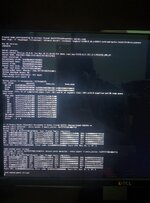How to Upgrade to macOS Sequoia on PC [Intel/AMD]
This guide describes how to upgrade directly to macOS Sequoia on Intel or AMD PC using Clover and OpenCore. By following this guide, you'll be able to upgrade an existing system running any macOS version provided that the hardware you have is compatible with macOS Sequoia.Overview
Apple announced its new macOS version i.e. macOS Sequoia (14.0) at WWDC23, which is the next major revision to its Operating System in the Macintosh lineup. As usual, a Developer Preview version will be available immediately for Developers who are enrolled in the developer program, and a Public Beta which is expected in July, coming this fall.
Although, macOS Sequoia is still in the beta phase, existing users running macOS Ventura or prior who wish to update their systems directly to macOS can upgrade now. Please be advised that due to being in the beta phase, it may contain several bugs and that is why it is not recommended to use it as a daily driver. This method does not involve bootable USB creation or such preparation and allows you to preserve your files along with the system settings.
If you plan to perform a clean installation, follow the guide linked below

GUIDE - How to Install macOS Sonoma on PC [Intel/AMD]
How to Install macOS Sonoma on PC [Intel/AMD] The following guide is a complete installation guide for installing a fresh copy of macOS Sonoma on PC. The post-installation has been covered in another section. The required tools and downloads are available at the forum. Overview Apple...
 elitemacx86.com
elitemacx86.com
Before you proceed with an upgrade, we suggest you to check the hardware compatibility of your system.

Requirements
Following are the requirements for upgrading your system to macOS Sequoia. Please ensure you meet the requirements before proceeding with this guide.
- A system running any existing version of macOS.
- A working Internet connection.
- At least 50GB of free storage space on the boot drive.
- If you're running OS X Mountain Lion, you must upgrade your Mac to OS X El Capitan first and then try upgrading to macOS Sequoia.
STEP 1: Back up your System
Before you proceed with an upgrade, we strongly recommend performing a full backup of your existing installation using Carbon Copy Cloner or Time Machine, or any other reliable backup/restore tool. In case the upgrade fails or you encounter any issues with the upgrade, you can always roll back to your existing installation.
STEP 2: Update Bootloader
Whether you're running Clover or OpenCore, you must update your existing bootloader to the latest possible version. Please note that as this is a new macOS version, the existing bootloader may not work properly, therefore you must use the latest commits of Clover or OpenCore for a hassle-free upgrade experience. If you're using Clover, you must update it to (5152) or later, and if you're using OpenCore, you must update it to (v0.9.3) or later. If you have used Xcode and know how to build kexts from source, build from the latest commit. Users who are new to Xcode can find the pre-built version of OpenCore in the attachment. This is mandatory for the smooth upgrade ensuring the update doesn't break the system and enter into a loop state or result in an unbootable system.
STEP 3: Update Kexts
Unlike the bootloader, you must update the kexts too. The essential kexts are Lilu, VirtualSMC, WhateverGreen, and AppleALC. If you're using some other kext and an update is available, you should update that too. If you have used Xcode and know how to build kexts from source, build from the latest commit. Users who are new to Xcode can find the pre-built version of the essential kexts in the attachment. This is mandatory for the smooth upgrade ensuring the update doesn't break the system and enter into a loop state or result in an unbootable system.
STEP 4: Update Kernel Patches
If you're using an AMD System, you'll also need to update the Kernel Patches. Do not use these Kernel Patches if you're using an Intel based CPU.
STEP 5: Update SMBIOS
With the release of macOS Sequoia, Apple has again dropped support for their obsolete Mac models (up to Skylake) and therefore you'll need to update the SMBIOS data to 2018 and later. To update the SMBIOS data, follow the guide linked below.

GUIDE - How to Setup Correct SMBIOS [Clover/OpenCore]
How to Setup Correct SMBIOS [Clover/OpenCore] This guide covers setting up a Correct SMBIOS for Intel and AMD CPUs on macOS using Clover and OpenCore. By following this guide, you'll be able to set up the correct SMBIOS on your system using Clover or OpenCore Bootloader. I. What is SMBIOS...
 elitemacx86.com
elitemacx86.com
STEP 6: Reboot System
After performing all the above steps, restart your system for the applied changes to take effect. It is recommended to reset NVRAM twice at least.
STEP 7: Download macOS Sequoia
As macOS Sequoia is not officially released for the general public, but only for developers, you would need an Apple Developer Account along with the Software Enrollment to download a copy of macOS Sequoia. However, if you've not enrolled, you can download an official copy of macOS Sequoia directly from Apple Server using the guide linked below.

GUIDE - How to Download macOS Sonoma without Developer Account
How to Download macOS Sonoma without Developer Account Today, Apple announced their new macOS lineup i.e macOS Sonoma 14.0. A copy of macOS Sonoma is currently available to developers who have enrolled in the Apple Developer Program. Users who have not enrolled in Apple's Developer Program...
 elitemacx86.com
elitemacx86.com
STEP 8: Upgrade to macOS Sequoia
Once you have everything set, the next step is to proceed with the upgrade. To upgrade to macOS Sequoia on your PC, follow the steps below.
1. From the Applications folder, right-click on Install macOS Sequoia beta.app and click on Open.
2. Click on Continue and then continue with the options as shown below.
When the installer prompts for access, enter your password and click on Unlock to allow access.
View attachment 6202
Now, macOS Sequoia will begin installing to your selected disk.
3. Once the first phase completes, the installer will prompt you for restarting your PC and your PC will restart automatically.
Here it ends the first phase of the installation. After restarting, it will continue the installation
Your PC will restart again and when your PC restarts, it will automatically boot from macOS Installer to continue the next phase of the installation. If for any reason, the installer does not auto boot, select macOS Installer in the boot picker and then boot. The installation will continue. If you choose to boot from Macintosh HD or (your drive name), the system will boot back to your previous installation without upgrading to macOS Sequoia.
View attachment 6247
View attachment 6248
Once again, your Mac will restart. Upon restarting, it will automatically boot from Macintosh HD to continue the next phase of the installation. At this point, the macOS Installer entry should not be present any longer. Upon completion, your PC will automatically restart. You'll see something as shown below.
View attachment 6249
View attachment 6250
Once again, your PC will restart, and when your PC restarts, it will automatically boot from Macintosh HD to continue the last phase of the installation. You'll see something as shown below.
View attachment 6251
View attachment 6252
View attachment 6253
View attachment 6254
View attachment 6255
After this process, your PC will complete the upgrade process and you'll be asked to enter your password to login into macOS Sequoia.
View attachment 6256
4. Enter your password and you have successfully upgraded to macOS Sequoia on your PC.
STEP 9: Complete Setup
When prompted for setting up a few newer options, set it up by following onscreen instructions.
View attachment 6257
Enjoy macOS Sequoia on your PC
Let us know your upgrade experience with macOS Sequoia. Please post all your support related questions in the Support forum sections.

